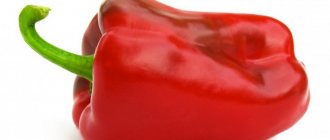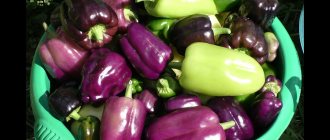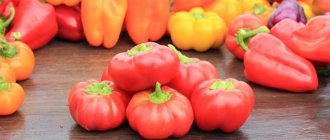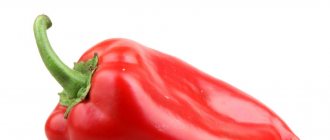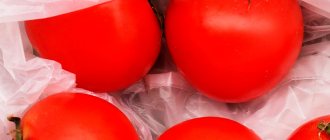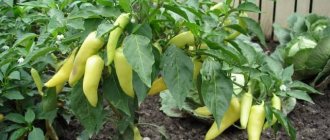Description of the pepper variety "Victoria"
Characteristics and description
Victoria pepper is early ripening, but in cooler climates it behaves like a mid ripening one. The fruits reach technical ripeness 110-130 days after planting in the ground. Biological ripeness occurs approximately on the 140th day.
- Standard and semi-standard bush; height – 45-60 cm;
- The bush is semi-spreading, compact;
- Productive: from one bush you can get 2-6 kg of peppers (depending on the degree of care and the external environment);
- Grows successfully in open ground, in small greenhouses, under film cover in beds;
- Cold resistant;
- High resistance to pepper diseases;
- The fruits are light green in technical ripeness, deep red in biological ripeness;
- Peppers are cone-shaped, slightly ribbed;
- Their length is up to 11 cm;
- Average weight is about 80-100 g;
- Wall thickness 4-7 mm;
- Peppers contain ascorbic acid and many vitamins and minerals;
- The pulp is sweet, aromatic, juicy, tender;
- The taste is pleasant.
Advantages and disadvantages
Victoria pepper is gradually expanding the zones where it successfully grows and bears fruit. It is still very popular among gardeners and farmers.
And this is thanks to its advantages:
- Stable, high yield;
- Resistance to low temperatures;
- Wide distribution area;
- Excellent transportability;
- Long shelf life;
- Unpretentious to weather and climatic conditions;
- Low maintenance requirements;
- Universal purpose;
- Resistant to many pepper diseases.
Features of growing the variety
Victoria peppers are grown like other pepper varieties. Agricultural cultivation technology is not particularly difficult.
Seeds are prepared for seedlings in mid-February: the seeds need to be soaked in a solution of potassium permanganate (for 30-40 minutes), then in clean water (for 12 hours); then place it on a cloth or napkin and keep it damp until the seeds hatch.
Plant the hatched seeds in cups, preferably peat cups for germination. Depth - 1-1.5 cm. Pepper does not tolerate transplantation well, so it is better either in peat cups or in separate pots, preferably two or three seeds in each. When warm days arrive, the seedlings need to be gradually accustomed to fresh air (if they are supposed to be planted in open ground)
It is good to take boxes with seedlings outside during the day (on the balcony, on the windowsill, on the porch, etc.), first for 25-30 minutes, then for a longer time, better first in cloudy weather, then in the sun, so that the sprouts accustomed to sunlight and not sunburned. It is necessary to plant seedlings when the soil is warm enough - peppers do not like cold soil
If the seedlings are in peat cups, they can be planted immediately without disturbing the roots; if in plastic ones, you must remove them carefully, without shaking off the soil from the roots. The distance between bushes is at least 50 cm; it’s better to use the square-cluster method - this way the plants are better ventilated and warm up in the sun
It is good to place the seeds on a damp cloth or napkin in a plastic bag, open it periodically for ventilation until the seeds hatch.
- Seedlings should be planted in the ground two months after germination, approximately in the second half of May-early June (depending on the region and weather conditions).
- Any soil is suitable for this variety, as long as it is loose.
- Victoria peppers need to remove leaves and shoots that begin to grow below the first fork on the trunk. If this is not done, the bush will begin to grow green mass instead of fruits.
- The variety loves regular watering, but the soil should always be moderately moist. Excessive watering will cause the roots to rot.
- Victoria loves weeding and loosening peppers.
- Responds gratefully to feeding.
Resistance to diseases and pests
The Victoria variety is resistant to typical pepper diseases:
- Verticella wilt;
- Black rot;
- Tobacco mosaic;
- Phytoplasmosis.
Video: Pepper - features of care, planting and growing
This is interesting: Pepper called Iolo Wonder is an excellent choice for amateurs and professionals - we consider it in detail
Characteristics and description
Victoria pepper is early ripening, but in cooler climates it behaves like a mid ripening one. The fruits reach technical ripeness 110-130 days after planting in the ground. Biological ripeness occurs approximately on the 140th day.
- Standard and semi-standard bush; height – 45-60 cm;
- The bush is semi-spreading, compact;
- Productive: from one bush you can get 2-6 kg of peppers (depending on the degree of care and the external environment);
- Grows successfully in open ground, in small greenhouses, under film cover in beds;
- Cold resistant;
- High resistance to pepper diseases;
- The fruits are light green in technical ripeness, deep red in biological ripeness;
- Peppers are cone-shaped, slightly ribbed;
- Their length is up to 11 cm;
- Average weight is about 80-100 g;
- Wall thickness 4-7 mm;
- Peppers contain ascorbic acid and many vitamins and minerals;
- The pulp is sweet, aromatic, juicy, tender;
- The taste is pleasant.
The purpose is universal: perfect for fresh consumption, excellent for canning. High shelf life and transportability make Victoria pepper attractive to farmers and those involved in the production of peppers on an industrial scale.
The undoubted winner among early sweet varieties is Victoria pepper: characteristics and description
When choosing new varieties, vegetable growers often return to the proven and high-quality Victoria pepper variety. Even a novice gardener can get a significant harvest with this crop.
Description and characteristics of the variety
Sweet pepper Victoria belongs to the category of early species. The stage of technical ripeness and harvesting begins after 105-110 days. The culture is standard. The variety has small semi-spreading bushes. The length of the stems does not exceed 50-60 cm.
Story
The variety was created by breeders from Moldova. The base for breeding was Lastochka and Gift of Moldova. Southerner bears fruit well in warm areas (Moldova, Ukraine, southern Russia). When cultivating in cool areas, planting is carried out in covered beds or in greenhouse structures.
After the seedlings take root, cold resistance increases. It is advisable to plant bushes after return frosts.
Appearance
Bell pepper Victoria is a classic in the line of similar varieties. Its fruits are brightly colored ruby when fully ripe. They have the shape of a cone with weakly defined 4 edges. What are the signs of peppers:
- average weight 90-100 g;
- length 8-10 cm;
- diameter 4-5 cm;
- wall thickness 6-7 mm;
- the skin is durable.
Utility
Victoria red pepper contains many useful substances - carotene, antioxidants, anthocyanins. Contains a variety of vitamins and microelements:
| Vitamins | Minerals |
| A | Potassium |
| E | Calcium |
| WITH | Magnesium |
| RR | Iodine |
| Group B | Phosphorus |
Viability
The variety is well adapted and is not afraid of common pathogens. Low susceptibility to the disease has been identified for the following infections:
- VTM;
- verticillium;
- black rot.
Thanks to their resistance to the listed pathogens, the fruits are well transported and can be stored for up to 4-5 weeks. Storage is carried out in the cellar, in vegetable warehouses at 5-7 degrees.
Advantages and disadvantages
Pros:
- endures the height of the heat;
- resistance to cold weather;
- ability to ripen outside the bush;
- juicy and meaty consistency;
- universal culinary use;
- transportability;
- long shelf life;
- strong resistance to a complex of pathogens.
Minuses:
the need for protection from insect pests.
Landing
Seeds are sown 65-70 days before the planned transplant to a permanent site. They adhere to the sowing period, which lasts from the 2nd ten days of February and throughout March.
Growing and care
To get a good harvest, adhere to the following algorithm:
Care techniques Nuances Watering Use a drip or hose system Water is poured into the root zone Moistening frequency up to 2 times a week Mulching The mulch is laid out in a layer of 6-7 cm Rotted sawdust, dry hay and straw are used Top dressing Up to 4 fertilizers are required per season Alternate minerals and organic matter The procedure is repeated after 2-3 weeks It is especially important to fertilize the beds before planting (in spring or autumn) and water the plants with a nutrient solution during flowering and ripening Weeding and loosening Remove weeds once every 10 days Hoes and hoes are used to process the beds
Pest Control
The main parasites are slugs, ticks and Colorado potato beetles. Getting rid of them is easy if you use the right drugs. It is advisable to carry out preventive spraying with folk remedies.
Colorado beetle
Damage is caused by larvae and adults. To process the whole plant, use Regent, Commander, Prestige, Taboo. The roots are soaked in Aktar.
Spider mite
The parasite infects leaf blades, causing wilting and stunted growth. To cope with the pest, garlic, bitter solutions, as well as chemicals are prepared. The bushes are sprayed 2-3 times at weekly intervals.
Slug naked
It feeds on fruits and leaves, leaving mucous cords and holes. Plants wither and disappear. Mustard, hot pepper, and Thunderstorm help get rid of parasites. To prevent mass damage, weeds are regularly removed. Lime is poured onto the beds when preparing the beds for crops.
Pepper Victoria does not require unusual care. If standard recommendations are followed, it produces peppers of high quality and excellent taste. Its fruits have a number of useful and medicinal properties.
History and characteristics of Victoria pepper
The “Victoria” variety was created on the territory of the Republic of Moldova from two equally well-known varieties (“Gift of Moldova” and “Swallow”) and, accordingly, is mainly grown in the same area. It easily takes root on the territory of Ukraine, as well as in the southern lands of Russia. It can also grow in colder areas, but this will require special conditions.
Previously, lush black soil was fundamental for its cultivation, but over the years, gardeners have ensured that Victoria pepper has adapted to the more complex soil composition that is used in greenhouse conditions. This variety is also distinguished by strong frost resistance, but only after it has taken root in the soil. Young sprouts still require protection from weather conditions, which is why experienced farmers recommend planting them after the May frosts.
Appearance
The appearance of the fruit is not much different from ordinary southern pepper. They are streamlined, cone-shaped, drooping towards the ground, the edges on four sides are virtually invisible. Their first maturity, called technical, gives them a green or light yellow color. Full ripeness turns them bright red. Each individual fruit reaches a fairly large size (up to 10 cm) and weighs approximately 100 grams, as it is distinguished by thick, fleshy walls.
Utility
Pepper fruits have an unforgettable rich aroma, they are juicy and rich in vitamins and minerals. They included:
- Vitamins C, E, A, B3, B5, B6;
- potassium;
- magnesium;
- sodium;
- phosphorus;
- calcium.
It is precisely because of its rich composition that Victoria pepper is useful to eat fresh. During heat treatment, the pepper pulp gives an unforgettable taste and aroma that will decorate any dish.
Viability
Pepper is resistant to black rot, fungal infection (pathogen from the genus Verticillium), and tobacco mosaic virus (TMV). Although it is worth noting that infection using the above method actively affects such a cultivated plant as pepper. That is why storage and transportation are a distinctive feature of the Victoria variety. For example, in a cellar, peppers can be stored for up to a month; the main thing is not to place the fruits close to each other.
Pest Control
The Bulgarian representative of this species is very resistant to various diseases. The exception is black rot.
Like other vegetables in garden beds, Victoria pepper is susceptible to a number of pests.
Colorado beetle
You can get rid of the Colorado potato beetle by spraying with celandine tincture. To do this, you need to put 1.5 kg of grass in a bucket, add hot water and leave for 3 hours. After this, add 1 liter of 1.5% calcium chloride solution.
Spider mite
Spider mites are afraid of onion solution. This is the most harmless and environmentally friendly product. To prepare it, take a bucket of onion peels and fill it with 2 buckets of hot water. The resulting solution is allowed to stand for 5 days, filtered, after which laundry soap is added to it (no more than 2 g per 1 liter).
Slug naked
The pest requires mechanical reprisal. You can also prepare a solution. To prepare the product, take mustard powder, ground red pepper and potassium salt, diluted in a proportion of 1 kg per 10 liters of water. The spraying procedure is carried out 2 times, the second - 30 minutes after the end of the first.
Pompeo F1 pepper is a new product in the world selection!
Strawberries "Sensation" from Garden
Strawberry variety Marshall, Agrofirm Victoria
1.Strawberry. What varieties of strawberries will never let you down?
Pepper variety "Victoria": key characteristics and agricultural technology of the crop
Growing sweet peppers in personal plots is a task that many gardeners face.
That is why most summer residents strive to find the most productive variety. An excellent solution, according to many gardeners, is Victoria pepper. This vegetable crop produces good fruits, the appearance of which can be assessed from the photo. High yield and friendly shoots are other advantages of the variety.
When describing this plant, it is also worth noting the excellent taste of the fruit.
Key features of the Victoria pepper variety
“Victoria” is a variety of sweet peppers created by breeders from Moldova back in 1979. The variety was the result of crossing the “Swallow” and “Gift of Moldova” peppers. The resulting plant is recommended for cultivation:
- in the North Caucasus;
- in Ukraine;
- in the Central Black Earth region of Russia.
The Victoria sweet pepper variety manifests itself in different ways.
Pepper "Victoria"
Often this variety is early ripening if conditions for the vegetable crop are favorable. In areas where summer temperatures are low, the variety appears to be mid-season. As a rule, technical ripeness of fruits occurs in 110-130 days. As for the period of biological maturity, it averages 140 days.
Attention! The speed of fruit ripening largely depends on the place of cultivation and the characteristics of the region. https://www.youtube.com/embed/7Vopw3pnKvw
https://youtube.com/watch?v=7Vopw3pnKvw
Bushes of the Victoria variety are semi-standard or standard. They belong to the category of medium-sized plants. As a rule, the height of the vegetable crop does not exceed 45-60 cm. The bushes of the plant are semi-spreading. At the same time, the compact vegetable crop is excellent not only for growing in open beds, but also under film covers or in small greenhouses.
Weight of one fruit - up to 100 grams
Description of vegetable fruits
One of the key features of the Victoria vegetable crop is cold resistance. That is why the variety is considered an ideal solution for most Russian latitudes. Other advantages include the variety’s resistance to:
- black rot;
- verticillium wilt;
- tobacco mosaic.
The fruits of the Victoria sweet pepper are slightly ribbed, drooping, and smooth. Their shape resembles a cone. During technical ripeness, vegetables are distinguished by a light green color. When peppers enter the stage of biological maturity, their surface acquires a rich red tone.
The vegetables this variety produces are quite large. Their weight varies from 70 to 100 g. At the same time, the length of the fruits, as a rule, does not exceed 11 cm. Another feature of the vegetable crop is the presence of thick walls. This parameter ranges from 5-8 mm.
From 1 sq.m. you can collect up to 7 kg of peppers
The high productivity of the variety can also be noted. From 1 sq. m. you can collect about 7 kg of vegetables.
Advice. The Victoria variety is suitable for commercial cultivation. The whole point is that vegetables are distinguished by good transportability and excellent keeping quality.
The pulp of this variety of peppers is very tender, sweet and juicy. It is characterized by an expressive aroma.
Pepper seedlings are transplanted into open ground after the optimum temperature without frost has been established.
Some tips for growing the variety
"Victoria" is cultivated by seedlings. Seeds for seedlings are planted in prepared soil in February. As a rule, from the moment of sowing to planting the seedlings, it takes from 8 to 10 weeks.
Usually, seedlings are brought to a permanent place in May or early June.
A unique feature of the variety is that the vegetable crop is able to adapt to any conditions, including rather difficult soil.
According to reviews from gardeners who have already cultivated the Victoria variety, you should not transfer seedlings to open ground when the risk of frost is still present.
Victoria pepper is rich in vitamin C and is excellent for fresh consumption.
The agricultural technology of this variety is considered standard. The plant requires weeding, regular watering, fertilizing and loosening the soil.
Pepper "Victoria" is unpretentious in care
"Victoria" is a variety of sweet pepper that is well known to many gardeners. Summer residents appreciate the high yield, unpretentiousness, excellent taste of the fruit and extreme simplicity in the growing process. The plant will appeal to both experienced and novice gardeners.
Characteristics of the variety
Pepper Victoria is an early ripening representative of the crop. The variety was bred in 1979 by crossing several species.
Victoria pepper grows in the northern regions in open ground and in greenhouses, which is a good indicator for cold areas. Here it is necessary not only to care for the crop with fertilizers and timely watering, but also to give the plantings additional heat.
It takes 115-128 days after the sprouts appear before the variety fully ripens. For 1 sq. m harvest up to 7 kg of fruit.
Description of the fruit
According to the description, the fruit of the Victoria variety is smooth and has the shape of a cone. The wall thickness does not exceed 8 mm. After ripening, the color of the variety gradually changes from green to deep red, which indicates a large amount of vitamins. The pulp of the vegetable is soft, sweet, juicy.
With proper picking of the bush, Victoria sweet pepper produces a large number of fruits: up to 25 pieces per bush.
During transportation and storage, the variety has proven itself well.
Description of the bush
According to their characteristics, the bushes are not too tall, spreading, quite compact, suitable for both greenhouses and open ground. The height of the bush with proper care reaches 50 cm.
Features of growing Victoria pepper varieties
Heat-loving sweet peppers need to be grown through seedlings, and only then planted in their permanent place of “residence”. Most often, gardeners plant sweet peppers in greenhouses; the summer season can be too unpredictable in most regions of Russia.
Seed preparation and sowing
In order to obtain full-fledged fruits, it is imperative to prepare the seeds for sowing. For this:
- soak the pepper seeds for 20 minutes in a solution of potassium permanganate, after which they must be washed with clean water;
- The seed material is treated with special growth stimulants.
After this, the seeds are placed in a damp cloth for germination. Containers with soil must be prepared in advance. Some gardeners prefer to first sow Victoria peppers in one container and then replant them in separate cups, while others immediately sow them in pots.
Temperature:
- during germination: +25…+30ºC;
- after the first sprouts appear: +18ºC (for about a week);
- then during growing seedlings before planting: +22…25 ºC.
Peppers need to be provided with good lighting, regular watering, and fertilizing.
A remedy that makes plants grow by leaps and bounds! Just water your plants with this Read more... NOTE! Additional illumination of pepper seedlings, like seedlings of other crops, is mandatory.
Watering should be moderate as the soil dries. Excess moisture is not allowed, as the seedlings may get sick and die.
The first feeding is carried out only when the peppers already have two or three true leaves. Use complex fertilizer. Next, two more feedings are carried out:
- the second – in two weeks;
- the third before landing in a permanent place.
Seedlings are ready for planting at the age of 90-100 days - in open ground, 60-70 days - in a greenhouse. Based on this, you can roughly calculate the timing of sowing and planting in the greenhouse. Seedlings should have 10-12 leaves.
IMPORTANT! Two weeks before planting, the peppers must be hardened. During the daytime, they are taken out onto the balcony, loggia, veranda. All sowing and planting dates are calculated only taking into account the climatic characteristics of the region
It is also important to take into account the weather in a particular year: early or late spring, air temperature
All sowing and planting dates are calculated only taking into account the climatic characteristics of the region
It is also important to take into account the weather in a particular year: early or late spring, air temperature
Planting and caring for peppers in a permanent place
In the greenhouse, a place for planting pepper seedlings is prepared in advance and fertilizers are applied. The best soils are light, loose, and breathable.
ON A NOTE! You cannot grow peppers after potatoes or tomatoes.
The Victoria variety is medium-sized; 25-30 cm between plants in a row will be enough. It is convenient to plant seedlings in holes in a checkerboard pattern, following the planting pattern.
The holes are spilled with warm water, plants are planted, then sprinkled with soil and compacted. If possible, it is recommended to mulch (peat or humus will do).
Further care is usual: do not forget to loosen, water regularly, provide good nutrition (feeding).
Watering
Peppers are very heat-loving, do not tolerate drafts, and require slight shaping of the bush.
Water frequently, but little by little, avoiding either excess moisture or drying out of the soil. The water should be warm and settled. If there is not enough time for care, it is recommended to mulch the peppers, which will provide the necessary moisture levels and also eliminate the appearance of weeds. The best mulch for peppers: peat, grass clippings, sawdust.
Features of cultivation and care
Caring for plants is easy
The Victoria pepper variety does not require special care.
Before the trunk begins to fork, the side shoots are removed so that the bush is not too dense, otherwise most of the plant's strength will be directed not to the fruit itself and its ripening, but to the growth of the trunk. The formation of the bush begins when it reaches a height of 20 cm.
After planting the seedlings, a number of actions are carried out:
- carry out regular watering (once a week): in hot weather it is increased (2-3 times a week), in cool weather it is moderated (once every 2 weeks); adhere to the proportion of 0.5 liters per bush);
- remove grass growing nearby;
- fertilize and fluff up the soil.
Fertilizer
Peppers are usually fertilized with urea. To prepare the mixture, add 1 tsp to 10 liters of water. urea and with 1 tbsp. l. double superphosphate. After the mixture has infused (after 2-3 hours), the crop is watered in the evening (0.5 liters of fertilizer for each bush).
